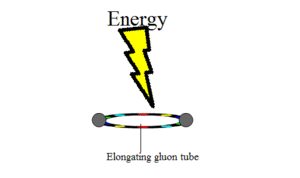- Color confinement
-
Color confinement, often simply called confinement, is the physics phenomenon that color charged particles (such as quarks) cannot be isolated singularly, and therefore cannot be directly observed.[1] Quarks, by default, clump together to form groups, or hadrons. The two types of hadrons are the mesons (one quark, one antiquark) and the baryons (three quarks). The constituent quarks in a group cannot be separated from their parent hadron, and this is why quarks can never be studied or observed in any more direct way than at a hadron level.[2]
Contents
Origin
The reasons for quark confinement are somewhat complicated; no analytic proof exists that quantum chromodynamics should be confining, but intuitively, confinement is due to the force-carrying gluons having color charge. As any two electrically-charged particles separate, the electric fields between them diminish quickly, allowing (for example) electrons to become unbound from atomic nuclei. However, as two quarks separate, the gluon fields form narrow tubes (or strings) of color charge, which tend to bring the quarks together as though they were some kind of rubber band. This is quite different in behavior from electrical charge. Because of this behavior, the color force experienced by the quarks in the direction to hold them together, remains constant, regardless of their distance from each other,[3][4] at around 10,000 Newtons.
When two quarks become separated, as happens in particle accelerator collisions, at some point it is more energetically favorable for a new quark–antiquark pair to spontaneously appear, than to allow the tube to extend further. As a result of this, when quarks are produced in particle accelerators, instead of seeing the individual quarks in detectors, scientists see "jets" of many color-neutral particles (mesons and baryons), clustered together. This process is called hadronization, fragmentation, or string breaking, and is one of the least understood processes in particle physics.
The confining phase is usually defined by the behavior of the action of the Wilson loop, which is simply the path in spacetime traced out by a quark–antiquark pair created at one point and annihilated at another point. In a non-confining theory, the action of such a loop is proportional to its perimeter. However, in a confining theory, the action of the loop is instead proportional to its area. Since the area will be proportional to the separation of the quark–antiquark pair, free quarks are suppressed. Mesons are allowed in such a picture, since a loop containing another loop in the opposite direction will have only a small area between the two loops.
Models exhibiting confinement
Besides QCD in 4D, another model which exhibits confinement is the Schwinger model.[5] Compact Abelian gauge theories also exhibit confinement in 2 and 3 spacetime dimensions.[6] Confinement has recently been found in elementary excitations of magnetic systems called spinons.[7]
See also
- Quantum chromodynamics
- Asymptotic freedom
- Deconfining phase
- Quantum mechanics
- Particle physics
- Fundamental force
- Dual superconducting model
References
- ^ V. Barger, R. Phillips (1997). Collider Physics. Addison–Wesley. ISBN 0201149451.
- ^ T.-Y. Wu, W.-Y. Pauchy Hwang (1991). Relativistic quantum mechanics and quantum fields. World Scientific. pp. 321. ISBN 9810206089.
- ^ T. Muta (2009). Foundations of quantum chromodynamics: an introduction to perturbative methods in gauge theories (3rd ed.). World Scientific. ISBN 978-981-279-353-9. http://books.google.com/books?isbn=9812793534.
- ^ A. Smilga (2001). Lectures on quantum chromodynamics. World Scientific. ISBN 978-981-02-4331-9. http://books.google.com/books?isbn=9810243316.
- ^ Kenneth G. Wilson, Confinement of Quarks, Phys. Rev. D 10, 2445–2459 (1974), http://prd.aps.org/abstract/PRD/v10/i8/p2445_1
- ^ Schön, Verena; Thies, Michael (2000-08-22). "2d Model Field Theories at Finite Temperature and Density (Section 2.5)". arXiv:hep-th/0008175v1 [hep-th].
- ^ See Lake et al, Nature Physics, 6, p50 (2010)
External links
Categories:- Gluons
- Quantum chromodynamics
- Quark matter
Wikimedia Foundation. 2010.


